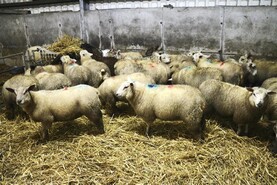The overwhelming majority of cattle on Irish farms are housed for winter. But there are some farmers working on drier land and able to winter a proportion of their herd outdoors.
On such land, crops such as kale and forage rape provide grazing late in the year, although they need careful management to keep cattle settled.
When it comes to grazing forage crops, outlined are some tips to manage animals through the winter.
1. Invest in good electric fencing
Forage crops such as kale are best strip grazed, so good-quality electric fencing is required. Mains electric is recommended to keep cattle from breaking through wires.
If mains electric is not an option, opt for a 12v battery unit with a solar panel fitted to maintain the charge. Use poly strands with at least nine strands of metal to carry a good current.
2. Setting up strip fences
Set up the strip wires so that the temporary fence provides the widest possible feed face. This will allow all cattle to graze at the same time.
Fences will need to be moved daily. It will take a couple of days to get a handle on how far to move the fence so that animals are not wasting any crop.
Make sure that leaves from the crop are not touching the electric wire, causing it to earth and reducing the current that keeps cattle breaking through the wire.
3. Gradually introduce cattle
Don’t just move cattle into a forage crop and give them ad-lib access on day one. Cattle should be gradually transitioned on to forage crops over a week to 10 days.
During this time, provide plenty of silage in ring feeders to keep animals full and restrict access to the forage crop with electric fencing.
4. Providing a lie back
Ideally, cattle will have a dry area as a run-back area for lying. A headland still in grass or access to an adjoining paddock make good lie-back areas.
5. Selecting cattle for grazing
Weanlings and light stores that will go back to grass next spring are ideal animals for grazing on forage crops.
Finishing cattle and stores that will be sold live in spring should stay indoors on good silage and concentrates.
Dry cows in good body condition can be grazed for a period to keep them fit. But they should be removed around six to eight weeks prior to calving, as kale and forage rape are low in minerals.
This could lead to issues around calving time. Thin cows and in-calf heifers should not be grazed on forage crops over winter.
6. Meeting cross-compliance requirements
Out-wintering cattle in rough weather can lead to heavy poaching of bare soil. There is also a risk of nutrient run-off from bare soil in wet conditions.
On fields with a slope, it is good practice to start grazing on the higher side of the field, then work towards the lower side, as this reduces the risk of surface run-off.
Also, avoid driving into fields with machinery to move fences and provide silage, as this only creates heavy ruts that hold water.
Silage bales should have been lined out in the field prior to grazing, so that it is only a matter of rolling a ring feeder by hand from bale to bale.
7. Grazing in frost
Grazing forage crops such as kale when they are frozen can kill cattle. Frost increases nitrates levels in forage crops, making them poisonous to cattle.
Therefore, on mornings when there is frost, hold off on moving the fence until the plant has thawed. Offer animals extra straw, silage or meal to keep them settled until the fence is ready to move.
8. Fibre
Forage crops are low in fibre, so cattle should always have ad-lib access to an additional fodder such as silage, hay or straw. Aim for a 50:50 ratio in diet between forage crop and silage.
As a rough guide to working this out, assume a group of 25 stores weighing 450kg normally eating 25kg to 30kg of silage indoors on an ad-lib basis.
On a 50:50 forage crop and silage diet, it means stores eat around 15kg of silage per day when outwintered.
If silage bales typically weigh 800kg, 25 stores will eat 375kg per day or roughly one bale every two days to allow for some waste silage in the feeder.
That means if stores are consuming a bale in less than two days, increase the area of fodder crop when moving the fence and vice versa.
9. Mineral supplementation
Kale and forage rape are low in minerals, particularly iodine. Therefore, animals need supplementing with minerals every day.
A mineral bolus is worth considering as it provides longer-term supplementation. Lick buckets are also an option, but not all cattle will use them.
Feeding powdered minerals daily also works well. To bulk out the minerals, mix with 1kg to 2kg/head of rolled barley.
Offer the barley and mineral mix just before you move the fence. This will draw cattle to the feed trough, keeping them out of your way as you move the fence.
10. Parasite control
Cattle wintered outside will be exposed to parasites such as fluke. Therefore, a follow-up dose in January or February will be required.






 This is a subscriber-only article
This is a subscriber-only article










SHARING OPTIONS: